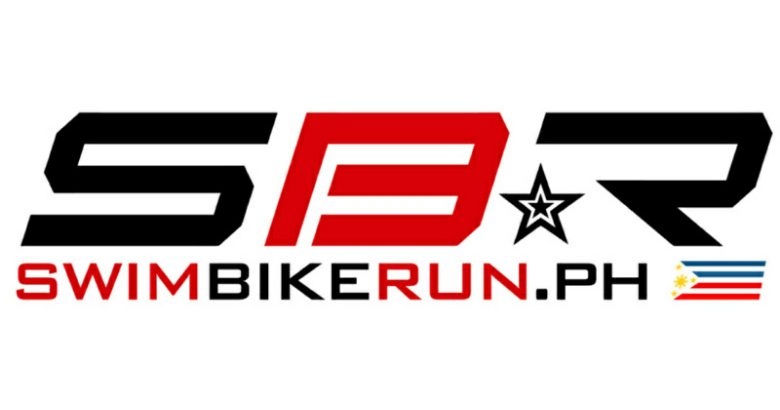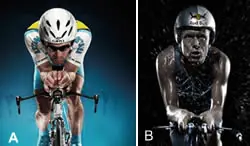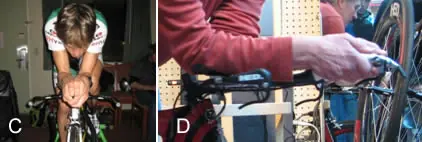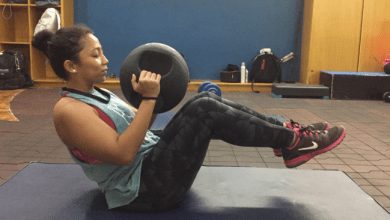On the Bike: Fit Versus Technique


Something has been lost in the recent bike-fitting craze. We’ve forgotten that it’s not just about the bike.
The typical fitting is all about setting up the bike to support an assumed position of the rider. The goal is a setup that creates an optimal blend of comfort, power and efficiency, but to actually get this result a fitter must devote just as much attention to the rider’s position, which cannot be taken as a given. Unfortunately, few fitters know much about rider positioning.
Worse, many triathletes don’t even bother to seek out qualified fitters to work on their positioning. On many triathlon forums, people post side-view photos of their positions and ask board members to critique them. The problem here is twofold. One issue is that air hits you from the front as you cut a hole through it, not from the side.
The second issue is that most of the people replying with positioning advice have never been in a wind tunnel nor are experienced fitters. In other words, they don’t know what they’re talking about.
Let’s look at what wind tunnel testing and real-world experience at the elite level tell us about proper positioning.
Know Your Resistance
There are three major forces that will hold you back when riding your bike on a flat to rolling course: mechanical resistance, rolling resistance and wind resistance.
Mechanical resistance is the least important. It is generated by the gears of your bike, which are fairly efficient, especially on a race-tuned bike, and in the bearings, which are also quite efficient. Rolling resistance is a little more complicated, as it varies by tire construction, inflation pressure and surface smoothness.
Both mechanical and rolling resistance increase in a linear manner, but wind resistance is different because, assuming that there is no change in your body riding position, it increases at the square of the increases in speed. The drag on a cyclist traveling at 20 mph is four times as great as the drag at 10 mph.
Thus, the faster you go, the more power is required to overcome wind resistance. In any given riding position, you need about 33 percent more power to go 10 percent faster. The good news is that you can reduce wind resistance at any given speed by manipulating your position.
The key is to cut down the frontal area of your position, forming your body into a more streamlined shape on your bike. Watch the Tour de France and you can tell which teams and athletes take this streamlined position seriously and which do not. The same goes for the front of most professional non-drafting triathlon fields.
A rule of thumb developed by Steve Hed, of Hed Cycling Products in Shoreview, Minnesota, is that you can save three seconds over 40 kilometers for every 10 grams of drag dropped. There are 454 grams in a pound; therefore, dropping a pound of drag can save you roughly 2.5 minutes over 40 kilometers and more than 11 minutes over an Ironman bike course.
Reducing Drag
The most effective positioning change you can make to reduce drag is to lower your head as much as you can toward your hands. This change alone has been shown reduce drag by more than 200 grams in the wind tunnel.

Photo A: Good head position. B: Poor head position.
Taller athletes typically cannot get their head as close to their hands as shorter athletes because of the length of their upper arms.
They can overcome this disadvantage to some degree by angling their forearms upward. When this is done properly, you can actually hear the wind resistance decrease.
The next biggest time savings comes from repositioning your shoulders. The objective here is to narrow your shoulders by rolling them inward. To do this, get into your riding position indoors and look directly into a mirror. See if there is a way to “shrug” your shoulders to be narrower. Modifying your elbow and hand position might make it easier.
The more your shoulders roll in the narrower your shoulders will get and the faster you will be. This can save you another 100 to 200 grams of drag. Again, angling your aerobars slightly upward might enable you to narrow your shoulders more comfortably. Moving your elbows closer together may also help.
We use giant calipers that we call “manipers” to measure shoulder width and ensure that as the elbows come closer together, the shoulders follow. Eventually, you will get to a point where your shoulders are unaffected by further reductions in the distance between your elbows, and that’s the point where you’ll want to stop (see photo C for an example of good, narrow shoulders).
Aero Positioning
There is no apparent effect of aerobar shape and aerodynamics. S-bends offer the most powerful position but are not necessarily the most comfortable. Finding a balance between power and comfort is important. While pulling up on the bar (which is a real power position), the more rotated your wrist becomes, the more leverage you can generate. The more angle there is in a single bend, the less power you will have pulling up.
The variety of hand positions that are possible with S-bends makes it easier to find a position that optimizes power and comfort. The key to proper S-bend positioning is to make sure that your ring finger is lined up with your elbow (see photo D). This will prevent the wrist and forearm discomfort often seen with ill-fitted S-bend aerobars.

Also, avoid angling your aerobars downward. This not only increases your frontal area, it also raises your effective bar height, causing you to ride “taller” and further increasing your frontal area.
Many triathletes assume that the surest way to increase the aerodynamics of the riding position is to drop your bars and lower your torso, but this is not always the case. A better indicator of aerodynamic positioning, from a side view, is how low the head is. A greater sternum angle may actually facilitate a lower head position because the rider is not forced to keep his or her head back to see forward (see photo E).
Using a goniometer, we measure an athlete’s sternum angle rather than hip angle. It is certain that if your sternum angle goes below five degrees, you will be slower than if it were at five to15 degrees. We actually raise some riders because their net drag is unaffected by going a little higher, as the steeper their torso angle is, the more they can lower their heads.
This is not to suggest that your back position is not important to aerodynamics. However, what matters is not how low it is but how you hold it. You want to strive for a slight curve in your mid-spine, almost like a hump. This will help integrate your aero helmet into your streamlined position (see photo F). Specifically, it will help smooth airflow over your aero helmet, integrating your aero tuck into a neat little package and lowering your drag numbers another 50 to 100 grams.

There is a principle in aerodynamics that states that air likes to flow over curved surfaces as opposed to flat ones. Consider the toroidal bulges of aero wheels versus flat sidewall wheels. If you have a naturally flat back, work on curving your back into a hump, and if you have a humpback, rejoice, because it will help you ride faster.
It is important to note that the best time trialers and triathletes in the world all work very hard to make the unnatural natural. Almost everyone who attempts to modify his or her position according the guidelines I’ve just given you comes back to me after the first few rides complaining about feeling uncomfortable.
Be patient, as it takes time to first get into the right position and then learn to pedal, steer, corner, drink and feed in it. When it does become tolerable and eventually comfortable (and it always does), your persistence will be rewarded with significantly faster bike-splits.
Source: Jason Goldberg Triathlete magazine










